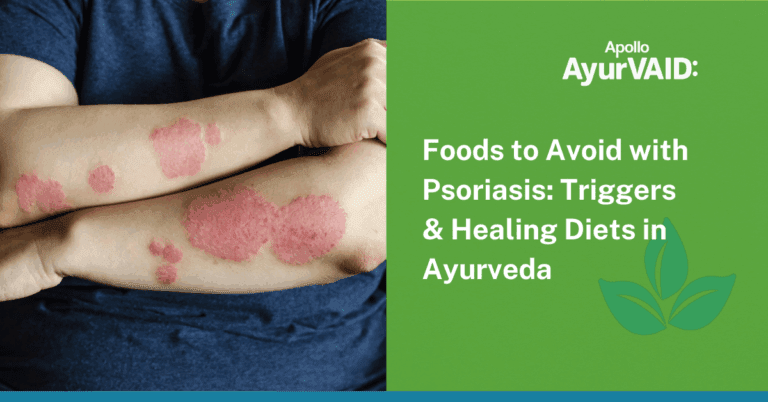When you mention having osteoarthritis, you’ll often hear random advice like “eat more calcium” or “avoid junk food.” While well-meaning, these suggestions can be confusing or incomplete. Naturally, you might turn to the internet searching for scientific and authentic food suggestions, because you already know that osteoarthritis treatment is incomplete without a proper osteoarthritis diet.
Ayurveda offers a proven, comprehensive method for treating this disease. It classifies osteoarthritis as a product of pained Vata dosha, the natural energy force for movement, dryness, and degeneration in joints. Ayurveda wisdom aims to provide relief through a balanced lifestyle along with an Ayurvedic anti-inflammatory diet. This approach encourages nourishing, grounding foods that soothe Vata and support joint repair, while advising you on foods to avoid with osteoarthritis, especially those that worsen inflammation and stiffness.
By adopting the right food for osteoarthritis, you can complement your medical or Ayurveda care and reduce pain, inflammation, and degeneration from within.

Understanding Osteoarthritis in Ayurveda
Osteoarthritis in Ayurveda is referred to as Sandhigata Vata (Sandhi=joint, Gatavata=imbalance of Vata becoming displaced in joints).
Ayurveda considers osteoarthritis as an imbalance of Vata dosha with the loss of Shleshak Kapha (synovial fluid). Conditions such as ageing, excess weight, improper diet, stress, or lifestyle cause disturbance in Vata, which then troubles the joints and causes dryness, rigidity, and pain. According to Ayurveda principles, food for osteoarthritis should be warm, moist, and digestible to counteract the dry and rough qualities of aggravated Vata.
Pathya Ahara - Food for Osteoarthritis
- Grains and Cereals: The best grains include Godhuma (wheat), Yava (oats), Shashtika (aged rice), and small quantities of Priyangu (millets). Rakta Shali (brown rice) and unpolished rice are especially helpful because they release energy slowly without aggravating Vata. Rakta Shali (red rice) contains anthocyanins that have anti-inflammatory and antioxidant effects, slowing down joint damage.
- Legumes and Pulses: The best among legumes is Mudga (moong dal) when not polished. These supply protein and are easier to digest than other legumes. Masura (red lentils) prepared with warming spices such as Ardraka (ginger) and Haridra (turmeric) are particularly useful for joints.
- Vegetables: Nutritious vegetables are ash gourd, bottle gourd, ladies’ finger, ridge gourd, onions, garlic, and ginger, prepared as curry with warming spices. Yams, carrots, and beans can be consumed in moderation. These vegetables should be cooked with Ayurvedic anti-inflammatory diet spices like turmeric, ginger, and cumin.
- Healthy Fats and Oils: Cold-pressed oils such as coconut, mustard, sunflower, olive, and sesame oil are recommended. Ghee, or clarified butter, is the optimal fat for joint lubrication and must be incorporated daily into an osteoarthritis diet. The healthy fats diminish stiffness in the joints as well as contribute to delivering essential nutrients for cartilage health.
- Anti-Inflammatory Spices: Key spices are turmeric, ginger, cinnamon, cardamom, cumin, coriander, black pepper, and asafoetida. Turmeric is rich in curcumin, a powerful anti-inflammatory agent that suppresses joint pain and swelling. Ginger is endowed with intense heat-activating and anti-inflammatory properties that suppress muscle pain and joint inflammation.
- Fruits: Recommended fruits include cooked apples with cinnamon, apricots, plums, bananas, grapes, cherries, soaked dates, coconut, figs, baked pears with warming spices, and seasonal fruits like mango, papaya, and oranges. These fruits provide antioxidants that help decrease inflammation in the joints.
- Dairy Products: Beneficial dairy includes non-pasteurised cow’s milk (boiled with warming spices like cinnamon and cardamom), fresh butter, soft paneer, ghee, and takra (buttermilk with roasted spice powder). These provide calcium and protein while being simple to digest when prepared properly.
Foods to Avoid with Osteoarthritis
- Nightshade Vegetables: Foods to avoid with osteoarthritis include nightshade vegetables such as tomatoes, potatoes, and eggplants, as they can aggravate inflammation in some individuals. These vegetables contain compounds that may worsen arthritis symptoms according to Ayurveda principles.
- Cold and Raw Foods: Naturally cold foods like raw salads, although rich in nutrients, have a cold nature that proves challenging to digest and aggravates Vata imbalance. Refrigerated and stale foods should be completely avoided as they increase Vata and reduce digestive fire.
- Processed and Junk Foods: Processed foods high in preservatives, additives, and unhealthy fats such as fast food, chips, and sugary snacks, can increase inflammation and aggravate doshas. These foods create toxins (Ama) in the body and worsen osteoarthritis treatment outcomes.
- Heavy and Difficult-to-Digest Foods: Foods to avoid include newly harvested rice, black gram in excess, deep-fried foods, and heavy dairy products like cheese and yoghurt. These foods are heavy to digest and promote Ama (toxin) formation, which worsens joint symptoms.
- Inflammatory Foods: Red meat and seafood should be avoided as they are considered heavy to digest and increase inflammation. Excessive salt, sugar, refined carbohydrates, and acidic foods also aggravate Vata and should be limited in the osteoarthritis diet.
- Ayurveda Dietary Guidelines: Meal Timing and Preparation According to Ayurveda, the ideal meal schedule includes breakfast at 7-10 AM, lunch at 1-2 PM, an evening snack at 4:30 PM (only if very hungry), and dinner at 7-9 PM. All meals should be served hot to maintain digestive fire and prevent Vata aggravation.
Cooking Methods
- Food for osteoarthritis should be cooked with warming spices and healthy fats. Soups of lentils and pulses should be prepared with ginger and black pepper. Steaming, boiling, and sautéing are preferred cooking methods over deep frying or raw preparations.
- Hydration: Warm water enriched with medicinal properties should be consumed throughout the day. Herbal teas made with ginger, cumin, coriander, and fennel seeds help improve digestion and reduce inflammation. Consuming these in moderation is recommended. Cold water and beverages should be avoided as they aggravate Vata.
Conclusion
An Ayurvedic anti-inflammatory diet for osteoarthritis emphasises warm, moist, and easily digestible foods while avoiding cold, dry, and processed items. The key is to pacify Vata dosha through proper food for osteoarthritis, regular meal timing, and appropriate cooking methods. This holistic approach to osteoarthritis treatment manages symptoms and addresses the root cause of joint degeneration by restoring doshic balance and improving overall digestive health.






